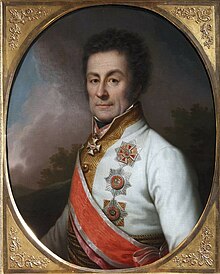
Back جوهان فون كلينوا Arabic چوهان ڤون كليناو ARZ Jan z Klenové a Janovic Czech Johann von Klenau German Johann von Klenau French Johann von Klenau Hungarian Johann von Klenau Italian 요한 폰 클레나우 Korean Johann von Klenau Portuguese Johann von Klenau Romanian
Johann von Klenau | |
|---|---|
 Portrait of Klenau from 1814 by Austrian painter Lampi the Younger | |
| Born | 13 April 1758 Benátky nad Jizerou, Bohemia |
| Died | 6 October 1819 (aged 61) Brno, Bohemia |
| Allegiance | |
| Service/ | Colonel-Proprietor – 5th Chevauxleger Regiment: 20 February 1804 – 10 June 1819 |
| Years of service | 1775–1819 |
| Rank | General of Cavalry |
| Battles/wars | War of Bavarian Succession Austro-Turkish War (1787–1791) French Revolutionary Wars Napoleonic Wars |
| Awards | • Knights Cross of the Military Order of Maria Theresa 30 October 1795 • Commanders Cross of the Military Order of Maria Theresa 13 July 1809 • Commander's Cross, Order of Leopold 7 January 1809 • Grand Cross, Order of Leopold 10 November 1813 Imperial Order of St. Alexander Nevsky (Russian) October 1813 Imperial Order of St. Vladimir 2nd Class (Russian), 1813 |
Johann Josef Cajetan Graf von Klenau, Freiherr von Janowitz (Czech: Jan hrabě z Klenové, svobodný pán z Janovic; 13 April 1758 – 6 October 1819) was a field marshal in the Habsburg army. Klenau, the son of a Bohemian noble, joined the Habsburg military as a teenager and fought in the War of Bavarian Succession against Prussia, Austria's wars with the Ottoman Empire, the French Revolutionary Wars, and the Napoleonic Wars, in which he commanded a corps in several important battles.
In the early years of the French Revolutionary Wars, Klenau distinguished himself at the Wissembourg lines, and led a battle-winning charge at Handschuhsheim in 1795. As commander of the Coalition's left flank in the Adige campaign in northern Italy in 1799, he was instrumental in isolating the French-held fortresses on the Po River by organizing and supporting a peasant uprising in the countryside. Afterward, Klenau became the youngest lieutenant field marshal[1] in the history of the Habsburg military.
As a corps commander, Klenau led key elements of the Austrian army in its victory at Aspern-Esslingen and its defeat at Wagram, where his troops covered the retreat of the main Austrian force. He commanded the IV Corps at the 1813 Battle of Dresden and again at the Battle of Nations at Leipzig, where he prevented the French from outflanking the main Austrian force on the first day of the engagement. After the Battle of Nations, Klenau organized and implemented the successful Dresden blockade and negotiated the French capitulation there. In the 1814–15 campaign, he commanded the Corps Klenau of the Army of Italy. After the war in 1815, Klenau was appointed commanding general in Moravia and Silesia. He died in 1819.
- ^ The youngest lieutenant field marshal not of the House of Habsburg. At age 20, Archduke Charles, Duke of Teschen, was the youngest.
© MMXXIII Rich X Search. We shall prevail. All rights reserved. Rich X Search